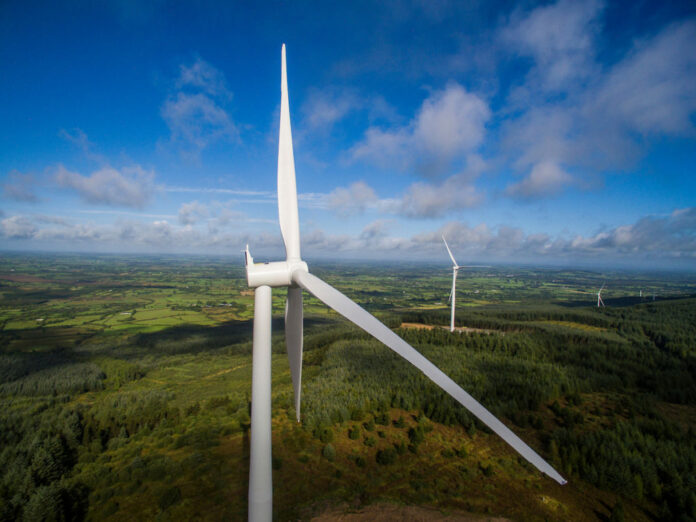THE development of onshore windfarms is critical for Ireland’s transition to a low carbon society, according to Pádraig Howard of Mid Clare Renewable Energy, and his company’s proposed new development at Cahermurphy would be fully in compliance with new draft national guidelines.
The so-called Cahermurphy II project has attracted a number of local objections and is currently with Clare County Council planners.
Mr Howard met with the Clare Champion at the site of the first Cahermurphy windfarm on Tuesday, and was actually interviewed while standing at the top of a stairwell on a turbine. While there have been concerns raised about the potential for noise from the proposed new windfarm, it was possible to have a conversation of almost 30 minutes without raising voices, while actually on the turbine.
On the day the wind speed was around 8.5 metres per second, and while this wouldn’t be exceptionally quick, Mr Howard said that the turbines were close to their most audible, because if the speed increased, the noise from the increased wind would mask them.
He said that developments of the type he is proposing are required, given the need to react to climate change. “I think it’s absolutely necessary if we’re to transition to a low carbon economy and a low carbon society. That’s ultimately what the world’s scientists say we have to do. There’s a climate crisis and biodiversity crisis.
“In the context of that, how do we achieve a low or a carbon neutral society by 2050? How do we meet our 2030 targets? We failed as a country to meet our 2020 targets, we fell short. Our 2030 targets require a 70% reduction over 1990 levels of carbon, how do we achieve that? If we can’t develop renewable energy projects in areas that have been identified as eminently suitable, where do we do them? People will say build off shore, wave, solar, all of those are elements that have to feed into it, but there will be a mix needed. For Ireland our greatest natural resource is our wind energy, be it off shore or onshore.”
When it was put to him that people may be cynical about a developer of windfarms speaking about their benefit to the environment he said, “People are cynical in today’s world about a lot of thing, what I’d say is don’t listen to the developer, listen to 98% of the world’s scientists.”
He stressed that the site where he is proposing to develop Cahermurphy II has been identified as particularly suitable for that purpose not by himself or his company, but by Clare County Council. “Everyone’s perception of an imposition is individual to them, it’s not for me to say that something isn’t imposing on someone else, you have to respect everyone’s view. What I would say is that the project that we’re proposing, Cahermurphy II, is on a strategic site. It has been identified by the local authority, they went through a full environmental assessment, a strategic environmental assessment, an appropriate assessment, three rounds of public consultation, and have been voted on by the elected members, on not one but three occasions.
“These areas have been identified as strategic areas, defined as areas that are eminently suitable for windfarms, and of regional and national importance.
“This isn’t developer led, it’s plan led, and it’s fully in keeping with policy.”
He also said that the Cahermurphy II would see no shadow flicker on people’s homes in the area. “We’ve committed to zero shadow flicker on any houses from Cahermurphy II in accordance with the new guidelines. We can model exactly when shadow flicker would fall on a house and the turbine is turned off for that period of time. What’s done then is the turbine is turned off for that period of time, that period of time might be 15-30 minutes per day for maybe two weeks of the year. It can be absolutely scientifically modelled and it can be eliminated and we’ve committed to that.”
He says the noise from the development would not be very loud, although he appreciates that some people have a different view. “What I would say to residents and people who have complaints that the relative change from a very, very quiet environment to one with 40 decibels or 45 decibels of background noise, is a big change for them, I don’t diminish that one iota, but it’s still relative. Forty five decibels is like a library environment, everybody knows libraries are pretty quiet places, but if you’re used to dead silence, going to a library environment is a significant change.”
Mr Howard feels that the potential benefits to the area have been underreported, and as well as 14 landowners benefiting, around €5.6 million would be available in the local area for community funding over the lifetime of the project.
As well as community organisations benefiting, he said that around 50% of the funding would go to people living close to the turbines, with houses there likely to get a figure of €1,000 to €2,500 per annum.
With vehicles and home heating set to run on electricity in the near future, he says Ireland has a means of generating a product that will be increasingly required and that can easily be exported. “We have a massive resource and product you can export in seconds.”
Owen Ryan
Owen Ryan has been a journalist with the Clare Champion since 2007, having previously worked with a number of other publications in Limerick, Cork and Galway. His first book will be published in December 2024.




